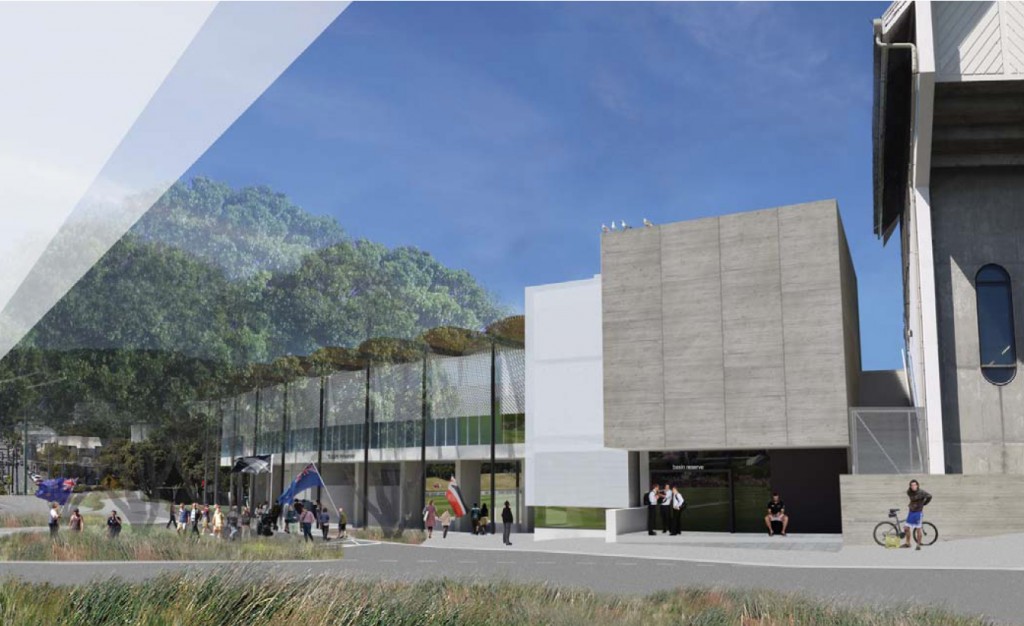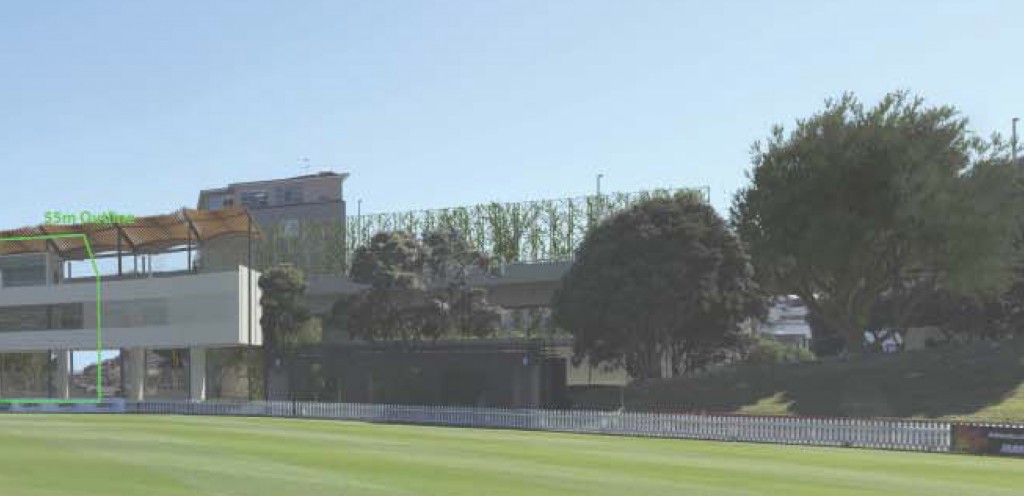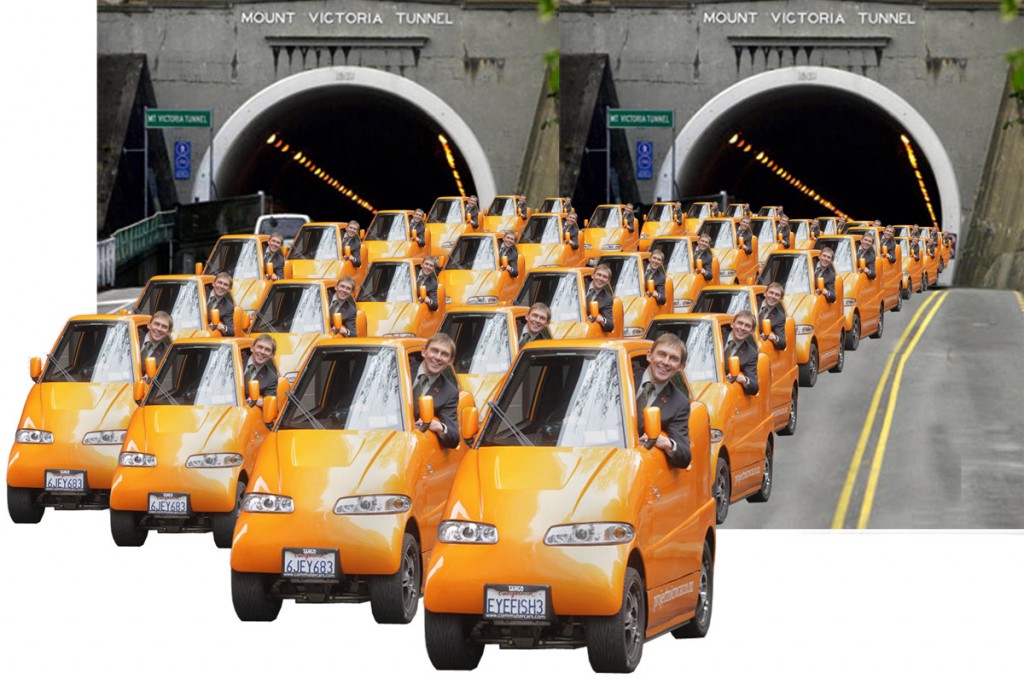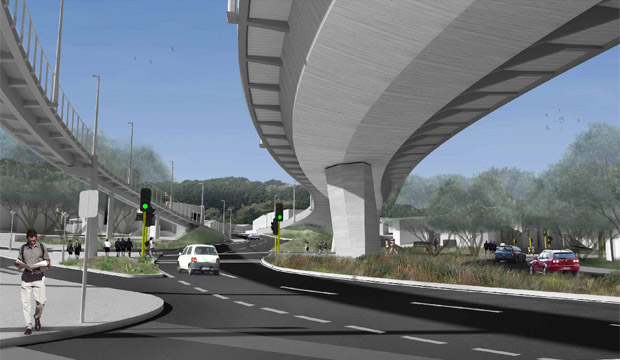The official Board of Inquiry report is due out on the 22nd July, but I wouldnt hold your breath if you think there is going to be anything radically different coming out of it. So, rather than waiting another day to have my suspicions confirmed, I’m going public today with an Eye of the Fish prediction: the Flyover will be approved tomorrow. I’d be more than happy to be proved wrong, but sadly, I think my prediction will be the obvious, pro-government, pro-roading lobby, pro-NZTA option A Bridge.

Not much of a surprise here really – the answer to the Basin Reserve traffic problem was always going to be a Flyover, as far as NZTA were concerned – and we all know that what NZTA wants, NZTA gets. The plan for the Flyover has been on the books since the days of the De Leuw Cathers report of the 1960s, and it hasn’t really budged since – about the only difference is that instead of going straight across the Basin Reserve at high level, they are now sneaking the Flyover past around the outside edge at a slightly lower level, in the hope that the International Cricket Council won’t delete the Basin Reserve from the list of top notch places to watch cricket.

Of the lengthy report to be issued by the Board of Inquiry tomorrow, there will of course be a large number of conditions, but nothing really that hadn’t been expected. The Eye of the Fish made a series of predictions a couple of months back when the hearing finished – were we right? In fact, I’m going to make some more predictions and even provide some answers too.
Flyover to go ahead – yes, of course.
Northern Gateway Building to be confirmed at 55m – right on that one too.
Green screen to be deleted – no, sadly, the Board hasn’t had the balls to say Balls to this most stupid of ideas, although I’m still fairly confident that it will either not get built, or will fall down over time – either way, it’s still a disaster of design.
Building under the Bridge – despite it’s Hobbit-like naming, it still gets the go ahead – it has to, it is a key part of the strategy to hide this goddam awful shitty Flyover from view as much as possible. Good luck with that!

No doubt there will be more conditions in the BoI report, which itself is quite lengthy, and has to be to try and justify the endless drivel of the Inquiry itself, which went on and on for more than is humanly possible to endure. As we noted at the time, the Inquiry was severely disappointing with it’s lack of investigation into the real issues – like how come NZTA were never sprung on how come they had blatantly lied and rigged the costings over the project and the alternative schemes put forward? Or why they don’t do the logical thing of implementing Richard Reid’s BRREO scheme in the mean time, just to see if it does indeed solve any traffic issues while we wait for the tunnels to be started?

At the end of the day, we all know that this scheme as it stands, is not going to solve the traffic snarl ups between the airport and the motorway. Yes, ultimately it will free up traffic to and from Newtown, zipping up and down Adelaide Road in a more carefree manner, but we all know that effect was not the primary aim for this – nobody in NZTA really gives a toss about Newtown. The primary aim, is of course for Government ministers to be able to catch flight NZ461 from Wellington to Auckland in time as soon as the House adjourns each night. And we also all know that this speed up of the traffic is not going to happen at all, until the second Mt Vic tunnel and motorway through Haitaitai is completed, zooming down the Road of National Party Significance.

So the big question that really counts therefore, is – will the Board of Inquiry link the two schemes together? There was a lot of discussion at the BoI about whether the cost-benefit analysis for the Basin works should include the Mt Vic Tunnel works as well, seeing as the traffic improvements were treated liberally wherever NZTA wanted to. Arguing at one minute that the Flyover was a stand-alone project, and the next minute that the benefits were shared with the tunnel, the whole scheme was fairly hopelessly presented by NZTA, trying, and no doubt succeeding to have a bob each way on the outcome. We did manage to find out that of the projected – what was it? 9 minutes of traffic saving? that only 90 seconds was attributable to the Bridge, while the majority of the rest of the savings were due either to the second tunnel (not built yet), or to the mysterious third lane in the Buckle St underpass (which is also not in this project, but, like the grumpy old Creche of Compassion, it seems to have been swept up and become part of the project anyway).





Let’s hope your prediction is proven wrong…
Wanna put money on it Denny? Or raise the stakes? Your car against mine?
Max, I found a picture of yours parked under a flyover… conflict of interest?
http://2.bp.blogspot.com/-wxtdbwZwE78/Tw5c_PGS1RI/AAAAAAAAHzk/g5jmXmCJVXw/s1600/Sashimi_Tabernacle_Choir_Art_Car_Central_01.jpg
My volvo ! I believe that was on a School Trip…
….waits for laughter, applause…
Come on Smart Arse, you haven’t forecast anything significant yet. What about the Bike Path? Are they going to approve it? Keep it the same 3m width? Require it to be wider – ie the 4.5m that regulations require / suggest? Or something else?
and lighting? wind? noise? screens? They were all issues that were explored too – what do you “predict” will be the result of those categories?
Now now, that seems a little harsh. Of course the bike path should be wider, we all know that. But then again, ain’t nobody gonna using that bike path anyhow, until they build a second tunnel and a bike path to Haitaitai…..
Of course, today’s impending decision is only the draft decision, not the final – and it will be conveyed just to the “interested parties” which is probably just NZTA, the Minister, and the 2 Councils involved. I suspect that the rabble of organizations protesting against the Basin Bridge will not get so much as a single email….
BZZT, your fish powers are weak old man
http://www.stuff.co.nz/dominion-post/10295908/Basin-Reserve-flyover-bid-turned-down
Max Fish – you had a 50/50 chance – ouch that must hurt. Report here:
http://www.epa.govt.nz/resource-management/NSP000026/NSP000026_NSP000026_Draft%20Report%20and%20Decision.pdf
Well The board have also given two fingers to the powers that be,
There is no Exec summary that I can find, so you actually need to read the 572 pages to actualy find out what the problems with it are, good luck finding a politician willing to speak to a 500 page report before they can be briefed on it
This is great news but it still raises the question (yet again): Why do we have a ‘transport’ agency that fails to see its remit as ‘transport’ not ‘roading’?
I know we ask this over and over but why do we never get a reasoned reply from the people responsible? They cannot be unaware of the mounting evidence that improving other forms of transport gets drivers off the road and that building more roads does not improve congestion. Why do these messages fall on deaf ears? You would think that in NZ where we can move fast that we’d be out in front with new ideas. God knows we have been leaders in market liberalisation and telecommunications over the years why not (at least in the vanguard, if not leading) with transport?
OK, I know its an apples to oranges comparison but let me go ahead anyway, there are lessons to be learned here. (And, yes, I did start writing this before today’s news so please bear with me). I’m currently living in Japan (although my heart is (usually) in Wellington). We are about 290 km from the main Tokyo international airport at Narita. When we plan holidays (or pickups from the airport) we NEVER even consider driving (this is also true when we’re planning to go from my mother-in-law’s place, 100km closer). There are many reasons, not all applicable to Wellington/NZ but here are the ones I can think of nonetheless:
* The trip would entail very high motorways tolls (about NZ$180 round trip) and of course expensive petrol (about NZ$1.80 p/l). Local roads are not a practical option as they are very crowded and sloooow.
* Driving that far on motorways is tedious and any travel times are only estimates which can fall (drastically) foul of congestion.
* Trains are more comfortable and less stressful and run ON TIME.
* Buses while slower, less convenient and less comfortable than trains (but cheaper) are still less stressful than driving.
* If the timetables permit and the three separate rail journeys meet up it can be faster. If the journey is longer (in theory, see point above about congestion) that simply means killing time in relatively interesting terminus stations (rather than trying to refresh ourselves in boring biscuit-cutter motorway stop areas).
* Parking is almost never free (or stress free) in Japan and certainly not at the airport.
So, for a single person driving would cost more ($180 + petrol) than taking the train which would be about about NZ$195 (less if you choose slower options). For two or more people driving starts to look attractive on paper but in reality we still don’t consider it because the alternative (even with suitcases) is just so much simpler, more comfortable and less stressful.
I know we don’t have road tolls in NZ but maybe we should? In Japan income taxes are low and they let the users pay (in a big way, see above) for the motorways, maybe people should be given that choice in NZ too? Unfortunately in Japan they already have both the ugly motorways and the ugly bullet train tracks so in a way its too late*. I know which one I would choose to both look at and to use in Wellington given the chance.
Thank you for your patience.
* I note that many places in the US are removing highways and reaping the benefits. https://duckduckgo.com/?q=removing+highways+freeways+motorways
Wow! – made my day
Wow indeed. The system (kind of) works.
Greenwelly – Josh – Chico – Denny – me, hurt? No, compadres, I’m absolutely overjoyed at being proved wrong. Staggered, well pleased, and highly impressed that the Board could see through the considerable amount of bullshit that NZTA threw up, and the the Board feel fit to turn them down. It is literally – back to the Drawing Board.
I’m going to take a couple of hours / days off to read this Draft decision.
Trying to find out exactly what is behind the reasoning of their incredibly succinct comment:
“APPLICATIONS FOR RESOURCE CONSENT
(NSP13/03.002; NSP13/03.003; NSP13/03.004; NSP13/03.005; NSP13/01.006)
The resource consent applications, being ancillary to the Notice of Requirement, are declined.”
Found it: ! The highly relevant bit is quite far in…
[1642] The Project would have an enabling element to the extent that it would fit well with the proposed works planned to implement the City Council’s Growth Spine from Ngauranga to the Airport. To this extent, it would be consistent with the transportation theme identified by the planning caucus and the integration of land use and transport planning.
[1643] Having said that, we are satisfied on the evidence that similar transportation benefits that would give effect to such integrated management could be achieved by a tunnel option or variant similar to Option X. We are also satisfied on the evidence that an at-grade option, along the lines of the BRREO Option, could facilitate some benefits, albeit not as well as the Project, at least until the Mt Victoria Tunnel duplication and possibly well beyond. We consider such options should have been included as part of a robust option evaluation process.
[1644] We now turn to whether the Project would give effect to the social and cultural enabling aspects of section 5 informed by Part 2, particularly:
[a] Section 6(e) (MÄori relationships);
[b] Section 6(f) (protection of heritage);
[c] Section 7(a) (kaitiakitanga);
[d] Section 7(c) (amenity values);
[e] Section 7(f) (quality of the environment); and
[f] Section 7(g) (finite characteristics of resources).
[1645] We have found that the Project would be an inappropriate development under Section 6(f) because of its effects on historical heritage.
[1646] We have also found that Sections 7(c) and (f) would be compromised by the Project as would, at least to some extent, Section 7(g).
[1647] To put it simply, the Project would result in significant adverse effects on the environment of this significant Basin Reserve area. It is significant for its geographical and topographical setting, its historical associations and its pivotal placement in the Wellington urban context.
[1648] In the final outcome, we are required to evaluate the significant adverse effects taken together with the significance of the national and regional need for and benefit of the Project. In carrying out this evaluation, we are conscious of the dicta of the Privy Council in McGuire that relevantly Sections 6 and 7 are strong directions to be borne in mind, and if an alternative is available that is reasonably acceptable, though not ideal, it would accord with the spirit of the legislation to prefer that.
[1649] This tension between the anticipated benefits and the anticipated adverse effects is the crux of the issues that have been debated before us. It reflects the tensions in Part 2. It reflects the tensions inherent in the statutory documents.
[1650] We are conscious of our findings as to the manner in which the Project would be consistent with the integrated planning instruments and documents relating to transportation. We are also conscious of our findings on adverse effects, which are contrary to the themes in the planning instruments on heritage, landscape, visual amenity, open space and amenity. As the planners agreed, the statutory instruments give no guidance on how this conflict should be resolved.
[1651] While the RMA does not require that an NoR must set out to achieve the best quality outcome, in our view, there are compelling landscape, amenity and heritage reasons why this Project should not be confirmed. The Basin Bridge would be around for over 100 years. It
would thus have enduring, and significant permanent adverse effects on this sensitive urban landscape and the surrounding streets. It would have adverse effects on the important symbol of Government House and the other historical and cultural values of the area.
[1652] Government House, like the Basin Reserve, has the important quality of rarity (there is only one such main residence of the Crown in New Zealand). The sensitivity of the area derives not just from Government House and the Basin Reserve but the overall national significance of the whole area from Taranaki Street to Government House.
[1653] The adverse effects are occasioned by the dominance of the Basin Bridge, resulting from its bulk and scale in relation to the present environment, and the future environment, which does not anticipate such a substantial elevated structure in this significant open space. The carefully crafted design of the Basin Bridge, together with the meticulously crafted landscape and amenity measures, while offering some offset, do not mitigate the bulk and scale of the Basin Bridge, exacerbated by the Northern Gateway Building.
[1654] The ultimate criterion is whether confirming the Notice of Requirement for the Project would promote the sustainable management purpose of the RMA. On that criterion, we judge that, even with its transportation and economic benefits, confiming the NoR would not promote the sustainable management purpose described in Section 5. It follows that the requirement should be cancelled. The resource consents, being ancillary to the requirement, are declined.
This is HUGE.
Also, isn’t it the first time that an board of inquiry has turned down a roading proposal?
Congrats to all involved, both sides, for robust discourse on an important site. Extra congrats to all those in the smaller organisations that put so much time and resources into this – top work!
I can see it now: “Political Correctness Gone Mad – let’s do away with that pesky RMA!”
How important are these Roads of National Party Importance to the Nats? Could we see another Canterbury Water Management Strategy scandal here or is it simply not important enough for them?
Josh Petyt – thanks for your comments. I’m interested that you are living in Japan – you say that you don’t consider driving – but that implies that you do actually own a car? Isn’t that unusual in itself? My impression of Japan was that, in the cities at least, car-ownership was quite low? Is that right? Care to comment?
And already in the Stuff comments section, the petro-Luddites are going ballistic. If they weren’t being so deadly serious, they’d be farcical. I do fear, however, that the current lot in power will have an attack of sour grapes and say, “Wellington’s full of latte liberals, and we can’t let them humiliate us like that! Maybe a good dose of CERA will sort them out!”
Great News!
Now the question to be asked is whether NZTA will eat their sour grapes, and take the funding earmarked for the flyover and send it elsewhere. I would encourage WCC, GWRC and NZTA to sit down and discuss how to work together, hear what the community is saying, and come up with some other options. I personally would like to see some concepts of a greater public transport scheme given some airtime in the mainstream media to judge the public attitude. It is one thing to discuss ‘light rail’, however I do not think the general public clearly understands what that actually is.
Having just travelled around Europe for three months I suggest:
1) Light rail line from the train station to Newtown
2) Light rail line from train station to Island Bay
3) Trolley/Hybrid bus connection from eastern suburbs to an interchange in Newtown
4)Upgrade of the cable car
5)Trolley/Hybrid bus connection from Cable car throughout Karori
Youre not wrong there Nick. NZTA went to considerable lengths to try and spin that what they had designed was a multi-modal public transport-enhancing solution, when in fact all they had was a big concrete bridge and some bike ramps to nowhere. I think the key will be to hold NZTA and WCC and WRC in a room until they have butted out a solution that works best for ALL modes of transport, nit just good for some and crapmfor others.
Hi Maximus
Yes we do own a car and yes in the inner city it is very common for people to not own a car because: public transport is plentiful; maintenance is costly; but probably most of all because there’s nowhere to park it. In fact when you first buy a car you must prove to the registration authority (Police, I think) that you have a parking space. Outside the inner-cities there are plenty of cars and too many roads. Wikipedia says that there are 591 cars per 1000 people in Japan to NZs 712*. If you have the time this article is a little old but a fascinating read: http://www.japantimes.co.jp/community/2009/04/21/issues/japans-many-roads-to-ruin/
We have been living in Japan (for the second time) since August 2011. We live in what is referred to by city folk as the countryside (inaka) although true countrysider’s who live off in ‘remote’ mountain valleys or tiny islands would doubtless call us ‘city slickers’ (to use the NZ vernacular). Everything is relative. We are three minutes walk from a station. 5 minutes cycle from two different supermarkets and about 15 minutes from an (out of town) shopping mall with department store, big box electronics store, massive $1.50 shop etc. It’s hard see where our (administrative) city ends and the next one begins. Our ‘city’ of about 60,000 is actually several towns and villages administered together over about 30 km of a river valley but the next ‘city’ along is probably the same again. Out here the trains only run about once an hour, sometimes a little more often during peak times and sometimes slightly less. The last trains at night are between 10~12 depending on where they terminate. But there are so many places we could’t get to without a car. Most houses have at least one car around here. We have a private/public rail line that goes 10 km! through to the next valley in addition to the main north/south JR line which runs parallel to the shinkansen (bullet train line) meaning we can get to a ‘superexpress’ station 10 minutes local train ride to the north and 25 minutes ride to the south. We also have a motorway off-ramp, which is not always a given in Japan because the toll booths are major installations. Suffice to say that we’re spoiled for infrastructure and unfortunately the infrastructure has spoiled Japan. It is so ugly. The link above really is a good read.
I have commented here before as just ‘Josh’ but I thought as there are other Joshes around I’d identify as Josh in Japan.
[…] July 21 (before the decision was announced): Surprise, surprise, the answer is a flyover […]